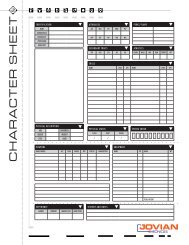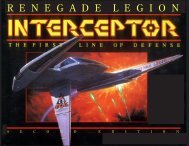renegadelegionneveren dingoffensive - Catsden.net
renegadelegionneveren dingoffensive - Catsden.net
renegadelegionneveren dingoffensive - Catsden.net
You also want an ePaper? Increase the reach of your titles
YUMPU automatically turns print PDFs into web optimized ePapers that Google loves.
VEHICLES<br />
Tchak’Mul Heavy Fighter<br />
Overview:<br />
The design process of an Interceptor usually follows familiar lines and<br />
paths. Designs usually begin with set weight or performance limits, and<br />
then the enginners try to cram as much into the fighter as they can. There<br />
are very few fighter designs where the primary aim hasn’t been that of<br />
‘the best it can be’, that is, a design that simply tries to do everything well.<br />
As a rule, specialization of fighter craft versus a single foe does not exist,<br />
except perhaps focussing on a particular range band.<br />
Perhaps one of the most scary assignments for a fighter crew to endure<br />
is the attack of an installation or, even worse, of the leviathan capital<br />
ships. Bristling with much defencive weaponry, plenty of power to drain<br />
into their shields and metres thick of armour, it is small comfort to the<br />
attackers that these targets are relatively immobile. It can take often times<br />
take many runs to scuff, let alone damage these behemoths. It takes the<br />
strongest of craft and the coolest of pilots to pull it off.<br />
Put these two together, and you have the background behind the Tchak’<br />
Mul (Thunderbolt). Designed by the Albedo group, the fighter has been<br />
specialized for attacking orbital installations and capital ships. No other<br />
fighter craft can claim the power the Tchak’ Mul does in terms of raw<br />
firepower when it unleashes... provided the target is willing enough to<br />
‘stand still’.<br />
Capabilities:<br />
When the Albedo Design group began looking at the idea of an antiinstallation<br />
fighter, the primary focus of investigation was, of course, the<br />
weaponry: how to pack the maximum punch into a craft of interceptor<br />
size. The more damage that can be dished out, the less time the craft<br />
spends exposed to enemy fire. Many combinations of weapon groups,<br />
coupled with missiles were looked at, with enocouraging results, but<br />
nothing was found that would significantly surpass fighters already in<br />
production.<br />
Ultimately, it was a human engineer who came up with the radical idea<br />
needed to give the craft its teeth. She noted that, compared to most other<br />
targets, the targets destined for attack by the new fighter would be relatively<br />
‘immobile’. Installations were in a fixed orbit, and both they and capital<br />
ships were very large in comparison to fighters, and hence the fighters fly<br />
around them as though the leviathan was a new ‘fixed point of reference’.<br />
What this means is that the weaponry fired at these targets didn’t need<br />
to have the blinding closing speed of standard anti-fighter weapons, they<br />
could be relatively slow. When she brought this insight back to the design<br />
team, it didn’t take long for the basic craft to be developed. Using the<br />
newer GMDC technology, the thunderbolt for the Tchak’ Mul is provided<br />
by no less than 5 “Heavy” Gatling Mass Driver Cannons.<br />
The actual strength of a shield, that is its pure stopping power, is generally<br />
irrelevant. The weaponry used in the modern theatres of war either<br />
pe<strong>net</strong>rate the shield, or do not. What the team discovered in this case,<br />
however, is that when the shield generators grow to the size they are in<br />
capital ships, the field strength actually became powerful enough to stop<br />
a regular GMDC shot. This forced the group to approach manufactures<br />
to create a heavy model, one that would pack enough energy and mass to<br />
punch through the shield.<br />
In the end, the Tchak’ Mul sports 5 GAU-Team Avenger HGMDCs,<br />
all mounted menacingly in the bow. This gives the Tchak’ Mul unprecedented direct-line firepower in<br />
the history of fighters, along with the added bonus of being shield ignoring. The Avengers, grouped<br />
together, are an impressive sight to behold when firing, the electrical discharge from the mag<strong>net</strong>ic linear<br />
accelerators shooting out like a muzzle flash. The shower of sparks that occur on the target as it attempts<br />
to absorb the impact is no less impressive. The Albedo group also added 6 hardpoints for secondary fire<br />
and defence. These are often loaded with special torpedos for attacking heavier craft.<br />
Though the fighter mounts no turret, the Tchak’<br />
Mul does carry a gunner, who’s role is tri-fold:<br />
to keep a lookout when the pilot is concentrating<br />
on a run, to lock and fire the missiles (the pilot<br />
firing the guns during the run) and to manage the<br />
shields. The Tchak’ Mul is the smallest craft to<br />
have adjustable shields. While not as adjustable<br />
as those in a corvette, this added flexibility<br />
proves very useful. The shields have three<br />
modes: normal, extra forward and extra aft. It is<br />
easy to determine the standard procedure. Extra<br />
power is shunted to the forward shields during<br />
a run, reversed towards the rear as the fighter<br />
shoots over its target.<br />
All this specialization for anti-capital ship<br />
warfare leaves the Tchak’ Mul rediculously<br />
vulnerable to fighter attack. Against fighter<br />
groups, the Tchak’ Mul is forced to rely on it’s<br />
missile load for defence. With 6 hardpoints,<br />
this is by no means something to laugh at,<br />
but it seriously limits any options for normal<br />
interceptor combat. Generally, if pressed into<br />
this situation, the Tchak Mul squadron will<br />
try to barrage fire it’s missiles at the incoming<br />
fighter group, in hopes of overwealming them<br />
in a single, swift strike. Fortu<strong>net</strong>aly, as can be<br />
expected of a craft attacking well defended<br />
opponents, the Tchak’ Mul has excellent allround<br />
armour as well as shield ratings, which<br />
can help it escape serious damage and live to<br />
fight another day.<br />
Deployment:<br />
The Tchak’ Mul has just finished it’s preproduction<br />
run, with a squadron having now<br />
been formed. Carefully planned raids with<br />
the new fighter have already taken place, and<br />
as expected, the results are nothing short of<br />
terrifying. In just a few runs, the Tchak’ Mul<br />
can reduce a typical small outpost to orbiting<br />
junk. The results against VCLA’s are even<br />
more violent and quicker. The craft has yet to be<br />
engaged by enemy fighters, however, and this<br />
could prove to be the real test. Until then, the<br />
Tchak’ Mul has fufilled all expectations. Pilots<br />
too have taken a liking to the stubby and slow<br />
craft. It looks likely that the Tchak’ Mul will<br />
go into full production in the very near future,<br />
striking out where others feared to tread before.<br />
Class: Heavy Fighter<br />
Mass: 321 tons<br />
Cost: 4,453,000<br />
Rating Power Mass Cost<br />
Right Engine 850 850 9 850000<br />
Cnter Engine 800 800 8 800000<br />
Left Engine 850 850 9 850000<br />
Links 2 2 2 400000<br />
Thrust: 4<br />
Shields Rating Power Mass Cost<br />
Front 80 96 2 40000<br />
Right 60 24 2 30000<br />
Left 60 24 2 30000<br />
Stern 60 24 2 30000<br />
Armour Points Power Mass Cost<br />
Front 100 0 10 500<br />
Right 100 0 10 500<br />
Left 100 0 10 500<br />
Stern 100 0 10 500<br />
Weapons Location Power Mass Cost<br />
Hard Point Left Wing 0 3 10000<br />
Hard Point Left Wing 0 3 10000<br />
Hard Point Left Wing 0 3 10000<br />
Hard Point Right Wing 0 3 10000<br />
Hard Point Right Wing 0 3 10000<br />
Hard Point Right Wing 0 3 10000<br />
HGMDC Bow 15 45 270000<br />
HGMDC Bow 15 45 270000<br />
HGMDC Bow 15 45 270000<br />
HGMDC Bow 15 45 270000<br />
HGMDC Bow 15 45 270000<br />
Crew and Cockpit Power Mass Cost<br />
Cockpit 1 1 1 10000<br />
Crew 1 1 1 1000<br />
Accel Comp 0 0 0 0<br />
Atmospheric Controls Power Mass Cost<br />
A-G Drives 0 0 0 0<br />
Streamlining 0 0 0 0<br />
Power Mass Cost<br />
Totals: 247 321 $4,453,000<br />
Excess Power: 2253------------------------<br />
V E H I C L E S TAT I S T I C S<br />
LV





